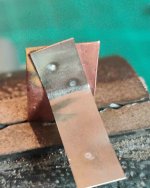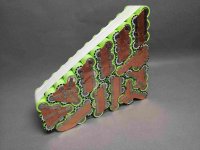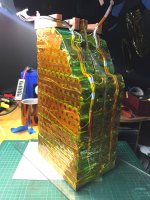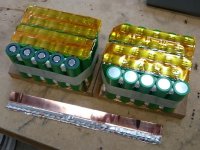badazzsteveo said:
Would cutting up the nickel strips into squares and sandwiching it with copper tabs reduce resistance that nickel has? It is like the picture below, but instead of using magnets, I'll use nickel that is cut into little squares.
What is the thickness of copper in that pack ? I'm guessing around 0.05mm ? Adding nickel squares and welding would allow thicker copper (~0.1mm).
But, IMO, copper and magnets seems like the ideal method for electrical connection between cells. I'll definitely be trying out magnets in my next pack build. I really think the magnet method is better for a lot of applications.
Pros:
- It doesn't put any heat into the pack during assembly.
- Copper is excellent conductor.
- Requires no additional equipment.
- Relatively foolproof.
- Easy to disassemble for repairs or reuse.
Cons:
- Additional cost of magnets, is arguable.
- Current capacity. 0.05mm copper limits the amount of current to about 20A per cell (@25A/mm2) for acceptable use. This is probably not a "con" in the majority of applications though.
- Copper to cell connection. The copper needs to be thin enough to match the cell terminal and achieve maximum/flush contact area. 0.05mm is nice and malleable, and could easily and quickly be pressed to the ends of the cells by hand during assembly. I think 0.1mm is probably borderline too thick to be malleable enough for ideal contact. You could make it work, but more time would need to be spent shaping the copper (especially if those plastic cell holders are used).
- Potential for corrosion. Adding some dielectric grease on the cell terminals before putting the copper on would stop the corrosion.
- Movement of the copper/magnets. Since the copper isn't permanently fixed to the cells, there is a chance that it could move. It would be a good idea to bond the copper to the cells at a couple of locations around the edges, and the magnets to the copper too.
- For packs with 2nd hand cells, the cell terminal might be a little rough and bumpy. That won't be ideal for this type of connection. More preparation would be required (smoothing and flattening), compared to welding.
Really, for most applications, the "cons" aren't an issue, and you're mostly left with the "pros".










